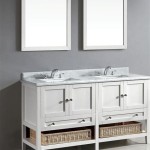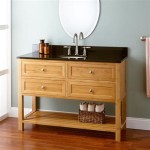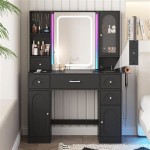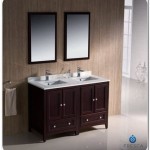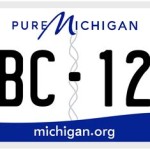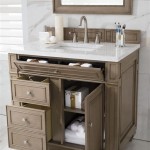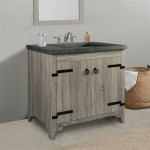Bathroom Vanity With Sink For Small Spaces: Maximizing Functionality and Style
Optimizing space in a compact bathroom requires careful consideration of every element, and the bathroom vanity with sink is arguably the most crucial. Selecting the right vanity can transform a cramped area into a functional and aesthetically pleasing space. This article delves into the intricacies of choosing a bathroom vanity with sink specifically designed for smaller bathrooms, highlighting key considerations and exploring various options available to homeowners and designers.
The primary goal in a small bathroom is to maximize usable space without sacrificing essential amenities. A well-chosen vanity not only provides storage but also serves as a focal point, contributing significantly to the overall design. Considerations such as size, shape, storage capacity, and style must be carefully evaluated to ensure the vanity fits seamlessly into the limited area.
Key Considerations for Small Bathroom Vanities: Size and Dimensions
The foremost aspect when selecting a vanity for a small bathroom is its size. Overly large vanities can overwhelm the space and impede movement, while excessively small ones may lack adequate storage. Prioritizing accurate measurements is crucial. Measure the available space meticulously, taking into account door swings, toilet placement, and any other fixed elements in the room. It is recommended to leave at least 24 inches of clearance in front of the vanity and around the toilet for comfortable maneuverability.
Vanity depth is also an important consideration. Standard vanities typically range from 18 to 24 inches deep, but shallower options, often ranging from 12 to 18 inches, are available specifically for small spaces. While a shallower vanity might offer less countertop space, it can significantly improve traffic flow in a narrow bathroom.
Height is another factor. Standard vanity heights are typically 30 to 36 inches. However, wall-mounted vanities offer flexibility in height adjustment, allowing for customization to suit individual preferences and accessibility needs. Properly chosen height can improve ergonomics and create a more visually open space.
Storage Solutions for Compact Bathrooms: Functionality and Organization
Maximizing storage is paramount in a small bathroom. A vanity with well-designed storage solutions can significantly reduce clutter and keep essential items organized and easily accessible. Consider vanities with drawers, shelves, and cabinets specifically designed for toiletry storage.
Drawers are particularly useful for storing smaller items such as makeup, brushes, and toiletries. Opt for vanities with multiple drawers or tiered drawer systems to maximize vertical space. Soft-close mechanisms are a desirable feature, preventing slamming and adding a touch of luxury.
Cabinets provide ample storage for larger items such as towels, cleaning supplies, and extra toiletries. Consider vanities with adjustable shelves to accommodate items of varying sizes. Some vanities also feature pull-out shelves or organizers for improved accessibility.
Open shelving can offer both storage and display space. While open shelving requires more diligent organization to prevent clutter, it can create a more visually open and airy feel in the bathroom. Baskets or decorative boxes can be used to conceal less aesthetically pleasing items.
Wall-mounted vanities offer a unique storage advantage by freeing up floor space. This not only makes the bathroom appear larger but also allows for easier cleaning underneath the vanity. The open space beneath the vanity can also be used for storing items such as scales or small stools.
Style and Material Choices: Aesthetics and Durability
The style of the bathroom vanity should complement the overall design aesthetic of the bathroom. A wide range of styles are available, from modern and minimalist to traditional and rustic. Consider the existing fixtures, color scheme, and architectural details of the bathroom when selecting a vanity style.
Modern vanities often feature clean lines, minimalist hardware, and neutral colors. These vanities typically prioritize functionality and storage with a focus on efficiency. Materials such as engineered wood, glass, and metal are commonly used in modern vanity designs.
Traditional vanities often incorporate ornate details, such as carved moldings, raised panel doors, and antique-style hardware. These vanities tend to evoke a sense of elegance and sophistication. Materials such as solid wood, marble, and stone are frequently used in traditional vanity designs.
Rustic vanities emphasize natural materials and a raw, unfinished look. These vanities often feature reclaimed wood, exposed hardware, and natural stone countertops. Rustic vanities can add a touch of warmth and character to a bathroom.
The choice of materials is crucial for both aesthetics and durability. Common vanity materials include solid wood, engineered wood, laminate, and metal. Solid wood is a durable and aesthetically pleasing option, but it can be more expensive and requires proper sealing to prevent water damage. Engineered wood, such as plywood or MDF, offers a more affordable alternative and can be treated to resist moisture.
Countertop materials should also be carefully considered. Popular options include granite, marble, quartz, and porcelain. Granite and quartz are highly durable and resistant to scratches and stains, making them ideal for high-traffic bathrooms. Marble offers a luxurious aesthetic but requires more maintenance to prevent staining. Porcelain is a cost-effective and versatile option that is available in a wide range of colors and patterns.
The sink type also impacts both the style and functionality of the vanity. Undermount sinks offer a seamless and easy-to-clean surface, while vessel sinks add a touch of visual interest. Drop-in sinks are a more traditional option that is relatively easy to install. The sink style should complement the overall design of the vanity and the bathroom.
Color selection plays a significant role in creating the desired ambiance of the bathroom. Lighter colors can make a small bathroom feel more spacious and airy, while darker colors can add depth and drama. Neutral colors such as white, gray, and beige are versatile options that can complement a variety of styles. Accents of color can be introduced through accessories such as towels, rugs, and artwork.
Hardware is another important element that can enhance the overall look of the vanity. Knobs, pulls, and faucets should complement the style of the vanity and the bathroom. Consider finishes such as brushed nickel, chrome, oil-rubbed bronze, and matte black.
Innovative Designs and Space-Saving Solutions
Manufacturers are continuously innovating to create bathroom vanities specifically designed for small spaces. These innovative designs often incorporate space-saving features and multifunctional elements to maximize efficiency.
Corner vanities are designed to fit snugly into the corner of a bathroom, utilizing often-overlooked space. These vanities are particularly useful in irregularly shaped bathrooms or those with limited wall space.
Wall-mounted folding vanities are a unique solution for extremely small bathrooms. These vanities can be folded up when not in use, freeing up valuable floor space. While these vanities offer minimal storage, they are ideal for powder rooms or guest bathrooms.
Vanities with integrated towel bars or shelves offer added convenience and space-saving functionality. These features eliminate the need for separate towel racks or shelves, reducing clutter in the bathroom.
Mirrored vanities can create the illusion of a larger space by reflecting light and adding depth. These vanities feature a mirror on the front of the cabinet, providing both storage and a reflective surface.
Vanities with built-in outlets and USB ports offer added convenience for charging electronic devices such as phones, tablets, and electric toothbrushes. These features eliminate the need for additional outlets in the bathroom, simplifying the electrical setup.
Floating vanities, also known as wall-hung vanities, are mounted directly to the wall, leaving the floor beneath them open. This design not only creates a more spacious feel but also makes cleaning the floor easier. The height of the vanity can be customized to suit individual needs, providing ergonomic benefits.
Ultimately, selecting the ideal bathroom vanity with sink for a small space involves a careful assessment of size, storage needs, style preferences, and budget. By considering these factors and exploring the various options available, homeowners can transform their cramped bathrooms into functional and stylish retreats.

Zeus Ruta 24 W X 18 D 34 H Single Bath Vanity In White With Ceramic Top For Small Space Semi Open Storage S Ainkbatr

24 Inch Brown Classic Style Powder Room Debellis Small Bathroom Vanity

Miniyam 22 Bathroom Vanity Sink Combo For Small Space Wall Mounted Cabinet Set White Wal Com

18 Free Standing Bathroom Vanity Cabinet Set Sink For Small Space W Door

Ravenna 60 Single Sink Small Bathroom Vanity Set 8 Drawers 1 Shelf Engineered Marble Top And Ceramic Vessel Cabinet With Mirror

15 Small Bathroom Vanity Ideas That Rock Style And Storage

Small Reclaimed Teak Bathroom Vanity

1 Set 18 Bathroom Vanity With Sink Inch Floating For Small Space Single Combo Modern

36 Bathroom Vanity With Sink Vanities Adjustable Shelf And Drawers Freestanding Storage Cabinet Single Combo Set For

24 Inch Bathroom Vanity With Sink Floor Mounted One Piece Cabinet Walnut Black Basin
